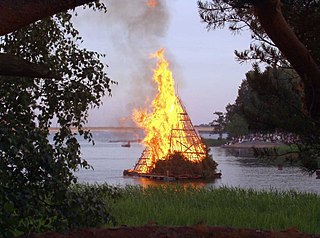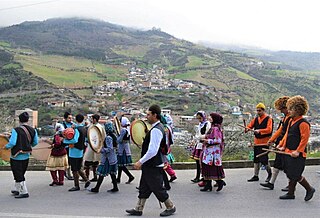A solar calendar is a calendar whose dates indicate the season or almost equivalently the apparent position of the Sun relative to the stars. The Gregorian calendar, widely accepted as a standard in the world, is an example of a solar calendar. The main other types of calendar are lunar calendar and lunisolar calendar, whose months correspond to cycles of Moon phases. The months of the Gregorian calendar do not correspond to cycles of the Moon phase.

A bonfire is a large and controlled outdoor fire, used either for informal disposal of burnable waste material or as part of a celebration.

Mazandaran province is one of the 31 provinces of Iran, located along the southern coast of the Caspian Sea and in the adjacent Central Alborz mountain range, in central-northern part of the country. The province, founded in 1937, covers an area of 23,842 km2.

Holi is a popular and significant Hindu festival celebrated as the Festival of Colours, Love, and Spring. It celebrates the eternal and divine love of the deities Radha and Krishna. Additionally, the day signifies the triumph of good over evil, as it commemorates the victory of Vishnu as Narasimha over Hiranyakashipu. Holi originated and is predominantly celebrated in the Indian subcontinent of India and Nepal, but has also spread to other regions of Asia and parts of the Western world through the Indian diaspora.

A solar term is any of twenty-four periods in traditional Chinese lunisolar calendars that matches a particular astronomical event or signifies some natural phenomenon. The points are spaced 15° apart along the ecliptic and are used by lunisolar calendars to stay synchronized with the seasons, which is crucial for agrarian societies. The solar terms are also used to calculate intercalary months; which month is repeated depends on the position of the sun at the time.

The traditional Chinese calendar divides a year into 24 solar terms. The first one is known as lichun in Chinese, risshun in Japanese, ipchun in Korean, and lập xuân in Vietnamese. It begins when the Sun reaches the celestial longitude of 315° and ends when it reaches the longitude of 330°. It more often refers in particular to the day when the Sun is exactly at the celestial longitude of 315°. In the Gregorian calendar, it usually begins around February 4 and ends around February 18. It is also the beginning of a sexagenary cycle.
The traditional chinese calendar divides a year into 24 solar terms.
Jīngzhé, 惊蛰, is the 3rd of the 24 solar terms (節氣) in the traditional Chinese calendars. It begins when the Sun reaches the celestial longitude of 345° and ends when it reaches the longitude of 360°. More often, it refers to the day when the Sun is exactly at a celestial longitude of 345°. In the Gregorian calendar, it usually begins around March 5 and ends around March 20.
The traditional Chinese calendar divides a year into 24 solar terms. Chūnfēn, Shunbun, Chunbun, or Xuân phân is the 4th solar term. It begins when the Sun reaches the celestial longitude of 0° and ends when it reaches the longitude of 15°. In the Gregorian calendar, it usually begins around 20 March and ends around 4 April. It more often refers in particular to the day when the Sun is exactly at the celestial longitude of 0°.
Lìxià is the 7th solar term according to the traditional Chinese lunisolar calendar, which divides a year into 24 solar terms.
Xiàzhì is the 10th solar term, and marks the summer solstice, in the traditional Chinese lunisolar calendar dividing a year into 24 solar terms.
Qīngmíng, Seimei, Cheongmyeong or Thanh minh, is the name of the 5th solar term of the traditional Chinese lunisolar calendar, which divides a year into 24 solar terms. In space partitioning, Qingming begins when the sun reaches the celestial longitude of 15° and ends when it reaches the longitude of 30°. It more often refers in particular to the day when the sun is exactly at the celestial longitude of 15°, usually on April 5.
The traditional Chinese calendar divides a year into 24 solar terms. Dōngzhì, Tōji, Dongji, Tunji, or Đông chí is the 22nd solar term, and marks the winter solstice. The term begins when the Sun reaches the celestial longitude of 270° and ends when it reaches the longitude of 285°. In the Gregorian calendar, it usually begins around 21 December and ends around 5 January.

Mazandarani is an Iranian language of the Northwestern branch spoken by the Mazandarani people. As of 2021, there were 1.36 million native speakers. The language appears to be decreasing, as it is threatened, and due to the majority of it's speakers shifting to Iranian Persian. As a member of the Northwestern branch, etymologically speaking, it is rather closely related to Gilaki and also related to Persian, which belongs to the Southwestern branch. Though the Persian language has influenced Mazandarani to a great extent, Mazandarani still survives as an independent language with a northwestern Iranian origin.

The Mazanderani people, also known as the Tabari people or Tapuri people, are an Iranian people who are indigenous to the Caspian sea region of Iran. They are also referred to as Mazanis for short. They inhabit the southern coast of the Caspian Sea and are part of the historical region known as Tabaristan. The Alborz mountains mark the southern boundary of the area settled by the Mazanderani people.

Chalus, also Romanized as Chālūs, Chaloos, Chalousse, Chalous, and Čâlus, is a city in the Central District of Chalus County, Mazandaran province, Iran, serving as capital of both the county and the district.

Caspian cuisine is a regional cuisine found in Northern Iran, primarily found in the Mazandaran, Gilan, Alborz, and Golestan provinces. The recipes are diverse, just like the region's landscape. Nature in the Mazandaran region of Iran is distinct and varied sections with a mixture of coastal, plains, prairies, forests, and rainforests. The Mazandarani cuisine of coastal regions is very different from that of mountainous regions since people settled in the Alborz usually use the indigenous herbs, while coastal populations prepare dishes using local fish and Caspian (Mazani) rice with vegetables.
Tokhü Emong is a harvest festival celebrated by the Lotha Nagas in the Indian state of Nagaland. The nine day Fall festival celebrates the end of the harvest season.
Haragapur is a village in Belgaum district in the southern state of Karnataka, India. It is attached to NH-4. Places to visit are Shivaji Fort, Mallikarjun Temple & Navanath Mandir. Village is located on Hilltop. Language spoken here is Kannada

Calendar Girls is a 2015 Indian Hindi-language drama film directed by Madhur Bhandarkar and co-produced by Sangeeta Ahir and Bhandarkar Entertainment. Akanksha Puri played a main female lead role. The film's music was composed by Meet Bros Anjjan and Amaal Mallik. The film released on 25 September 2015. According to Bhandarkar, the story of Calendar Girls is 75% reality and 25% fiction.













